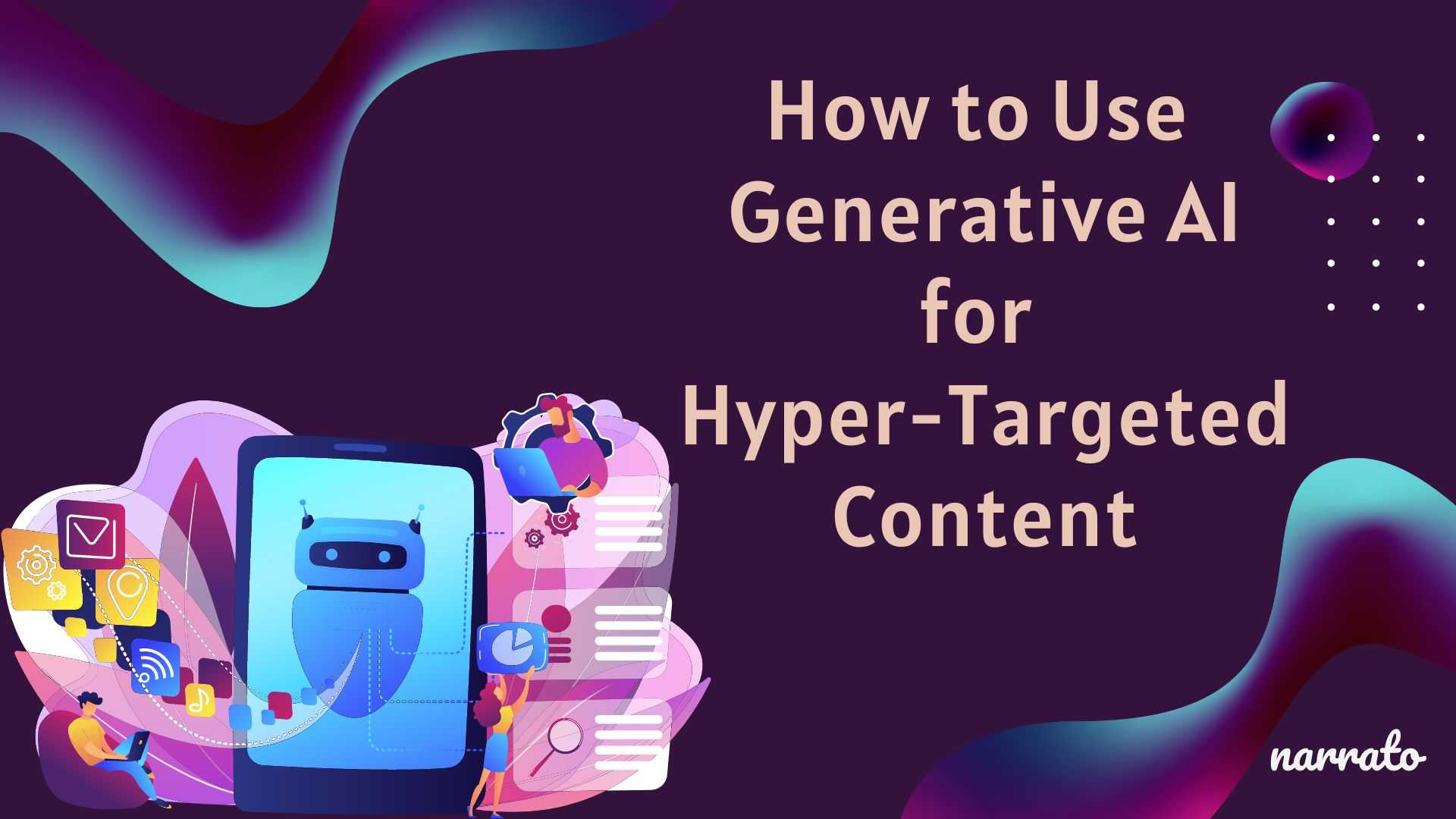Generative AI is the present and future of content creation. It can help you generate hyper-targeted content for your audience. But how to use generative AI to create engaging and effective content that resonates with your target audience?
When you talk about generative AI, it is important to remember we are not talking only about AI writers. While generating text for your written content is one of the most widely used applications of generative AI tools, there are so many other areas where generative AI can play a crucial role. Starting from audience and market research to content ideation to analytics, generative AI is creating waves and changing the world of content marketing as we know it.
In this article, we will explore how generative AI can enhance your content strategy and provide tips to get you started. So, if you’re looking for new ways to improve your content creation process, read on!
TL;DR here’s a quick video summary of the article.
How does generative AI benefit content creation?
How to use generative AI to create hyper-targeted content
- Create hyper-personalized copy
- Elevate your blog posts with generative AI
- Get inspiration and ideas from generative AI tools
- Create engaging scripts for your videos and podcasts with generative AI
- Translating content with generative AI for localization
- Generate contextual and personalized images for ads and more with generative AI
- Generate audio and video content with generative pre-trained AI tools
Best practices when using Generative AI for creating hyper-targeted content

What is generative AI?
Generative AI, in simple terms, is artificial intelligence that uses algorithms to generate new content. This could be text, images, videos, audio, or other content too. Generative AI tools are trained on massive datasets of online and offline content, helping the deep-learning models understand patterns, similarities, structure, and other aspects of the content created by humans. The algorithms can then perform a number of downstream activities like generating art, predicting the next words in a sequence to create meaningful sentences, and so on.
So when you offer a text prompt to a generative AI tool, it associates the prompt with what it has learned from the training data and generates new content based on this learning.
How does generative AI benefit content creation?
When it comes to content creation, generative AI gives limitless opportunities to improve quality, speed, and efficiency. Some of the biggest advantages of using generative AI in content creation include –
- Idea Generation: Generative AI can help spark creativity by generating new ideas for content. By training on a wide range of existing content, AI models can generate unique concepts, angles, and themes that human creators might not have thought of.
- Automated Content Production: Generative AI can automate the content creation process by generating text, images, videos, or even audio content. This can save significant time and effort for content creators, allowing them to focus on higher-level tasks such as strategy, editing, or customization.
- Personalization and Customization: Generative AI can help create personalized content at scale. By leveraging user data and preferences, AI content generators can create content that resonates with specific individuals or target audience segments. This boosts the relevance and effectiveness of the content, leading to better engagement and conversion rates.
- Content Variation and Adaptation: Generative AI can generate multiple variations of a given piece of content. For example, it can create different headlines, introductions, or calls to action for an article. This enables marketers to A/B test different versions and optimize their content based on performance.
- Language Enhancement and Grammar Checking: Generative AI models can assist in improving the quality of written content. They can act as grammar checker tools and also identify spelling or style errors, ensuring that the content is polished and professional. This can be particularly useful for content creators who may have language barriers or require additional proofreading support.
- Content Curation and Recommendation: Generative AI can help curate and recommend relevant content to users. By analyzing user preferences, browsing behavior, and content metadata, AI algorithms can suggest articles, videos, or products that align with the user’s interests, driving engagement and user satisfaction.
- Multimodal Content Generation: Advanced generative AI content creation tools can generate content across multiple modalities, such as combining text with images or videos. This opens up new creative possibilities for content creators to deliver compelling and immersive experiences with AI-generated content.
How to use generative AI to create hyper-targeted content
Generative AI can bring phenomenal results in your content marketing campaigns if it is used at the right moments and in the right way. In a McKinsey survey, almost 55% of respondents said they saw a significant impact of using generative AI in marketing optimization, and 50% said the same for applications in dynamic content such as websites and marketing collaterals.

Source: McKinsey
So what is the right way to use generative AI in content creation to maximize ROI and give your audience a hyper-personalized experience? Here are some very useful tips.
Create hyper-personalized copy
The biggest advantage of using generative AI in content creation is its ability to decipher historical data and identify audience preferences, purchasing behavior, and other characteristics. All you have to do as a marketer is define who your target audience is and the generative AI tool can easily determine behavioral patterns and preferences to give you content tailored to your prospects.
Here’s an example of how ChatGPT can tailor your copy for different audiences.
In this example, we asked ChatGPT to create an ad copy for a gaming console with the target audience as older men between 35 and 40 years of age
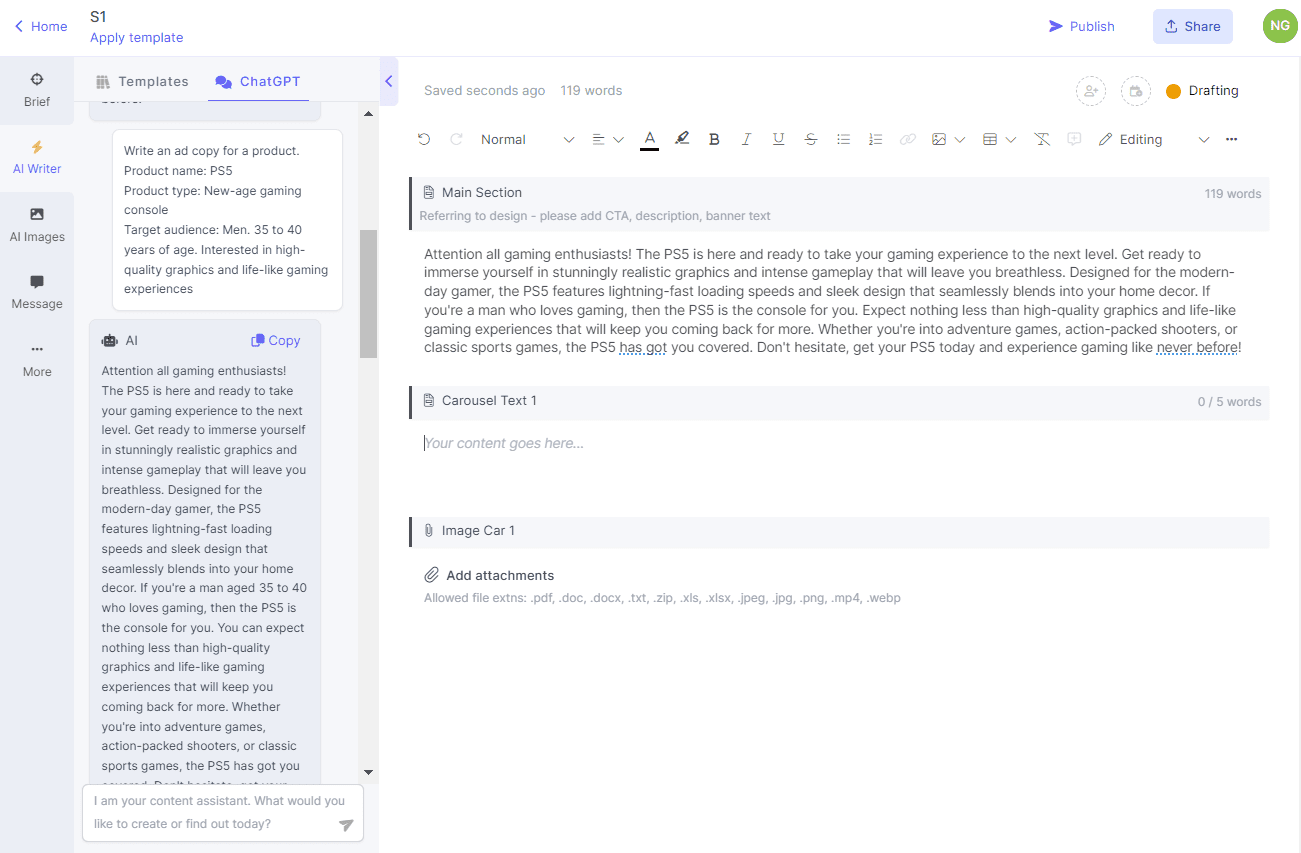
In the next example, we asked the AI writing tool to generate the same ad for boys between 12 and 18 years of age, and with different interests accordingly.
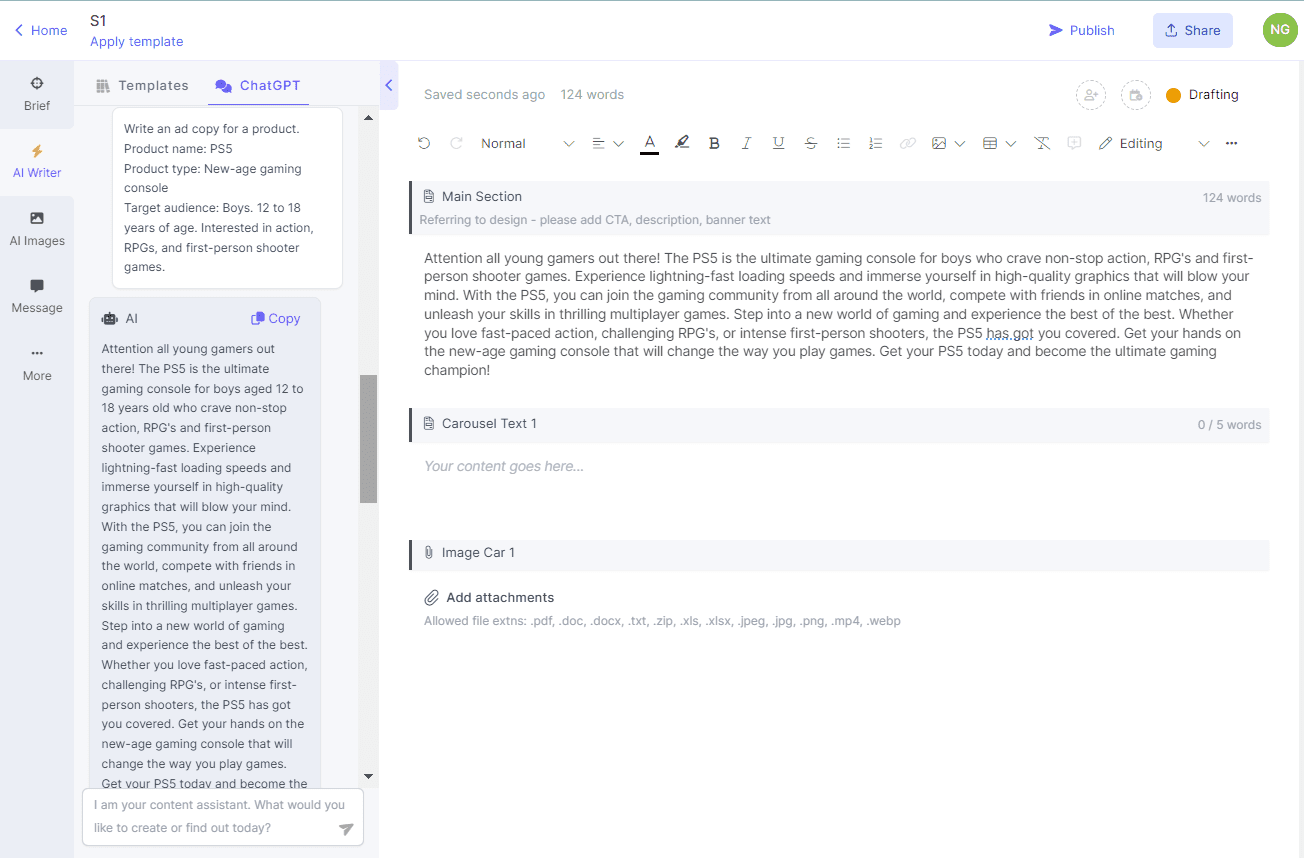
As you can see, the two versions of the ad copy are quite different in the way they address the audience and highlight key features of the product. You can further refine the copy by defining the tone you want or describing your target audience more elaborately.
It is, however, important that you have a good understanding of your target audience persona before getting down to work with a generative AI tool.
Elevate your blog posts with generative AI
AI writing tools can help you create hyper-targeted blog posts as well. But what exactly do you mean by hyper-targeted blog posts? Well, that would mean content that addresses the right questions and offers solutions that your audience is looking for. A lot depends on the input you provide your AI content creation tools with. Most AI blog writers will ask you to define your target audience. Some generative AI tools can also help you find the most relevant keywords, questions, and topics that can help you reach the right audience.
Narrato’s SEO content brief generator is an example of an AI tool that helps with this. The AI-generated SEO content brief on the platform gives you top keyword recommendations along with counts, questions to answer, competitor links to benchmark against, and more. This can help you create highly targeted content that will appear in the right searches and increase your chances of being seen by a relevant audience.
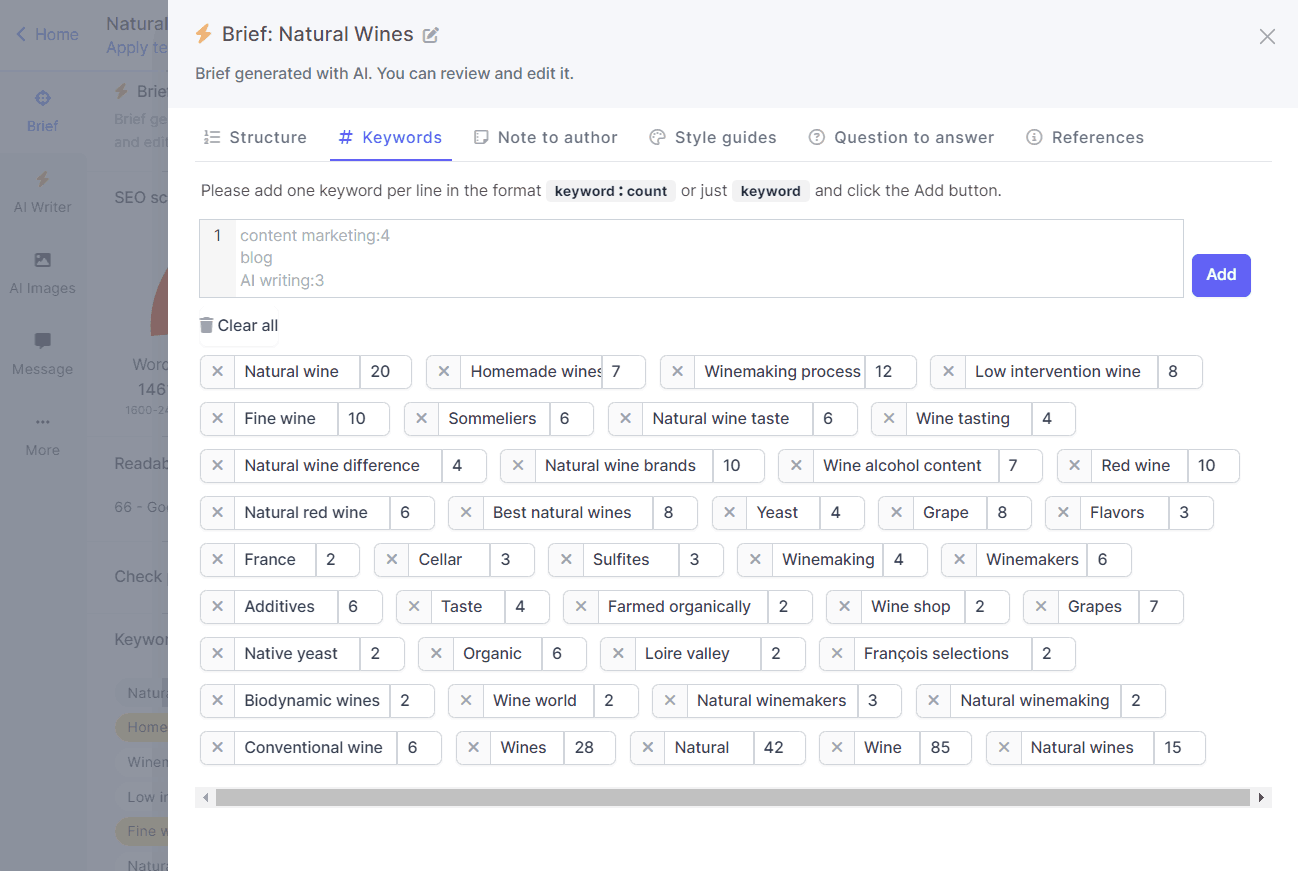
Generative AI tools can also be trained to give you highly relevant and accurate output. With AI models like GPT3, you can further train the language model by providing it with more data related to your audience and the kind of topics you usually work on. With other models like ChatGOT, you can train it by providing better instructions and guidance through your prompts. We’ve done a detailed post on how to use ChatGPT for content creation that may help you with this.
The more context you provide the AI content creation tool with, the more targeted its output will be.
Get inspiration and ideas from generative AI tools
Another interesting application of generative AI is in content ideation and research. There are tons of AI idea generator tools that can help cut down the time you spend on brainstorming and provide you with preliminary ideas to build upon. Here’s an example from Narrato’s AI topic generator tool that shows you how you can get blog post ideas using AI.
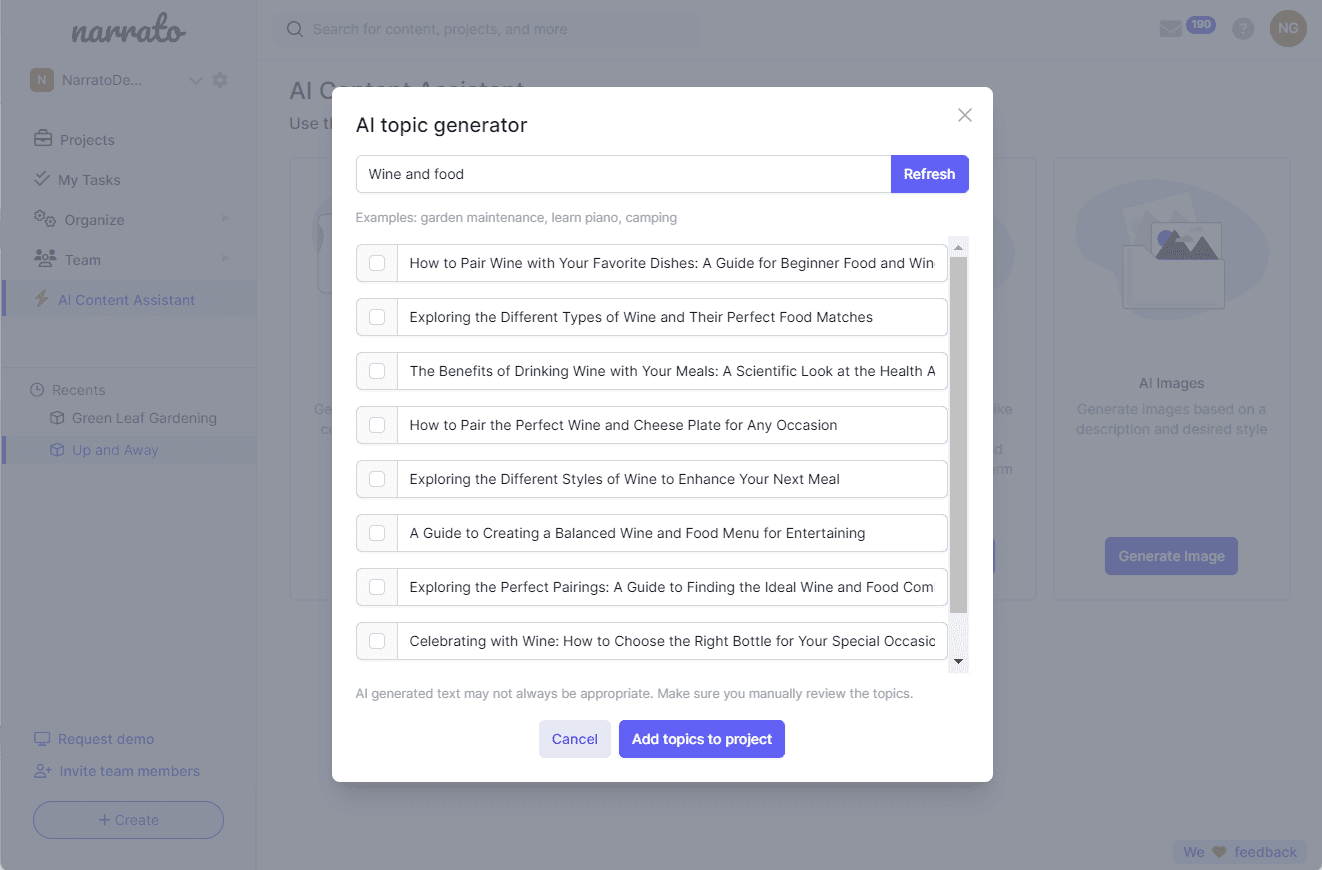
AI content generators like Narrato, ChatGPT, or TLDRThis can also help you collate your research around these topics. Generative AI can be great for summarizing content and this feature can be easily applied to your content research. So instead of reading through an entire article or report, you could simply ask an AI text summarizer to give you a gist of the content.
Generative AI tools can save you a lot of time and help you create well-researched, relevant content for your audience at half the effort.

Create engaging scripts for your videos and podcasts with generative AI
AI content generators can be great at storytelling too. This may have seemed like a distant dream until a few years ago, but generative AI tools are actually creating stories and scripts for your multichannel content marketing campaigns today. You can use AI script generators to create the first draft of your video, podcast, or ad scripts.
Generative AI tools like Narrato can generate script outlines, highlighting the key points of discussion in your videos and podcasts. Here’s an example of how that might look.
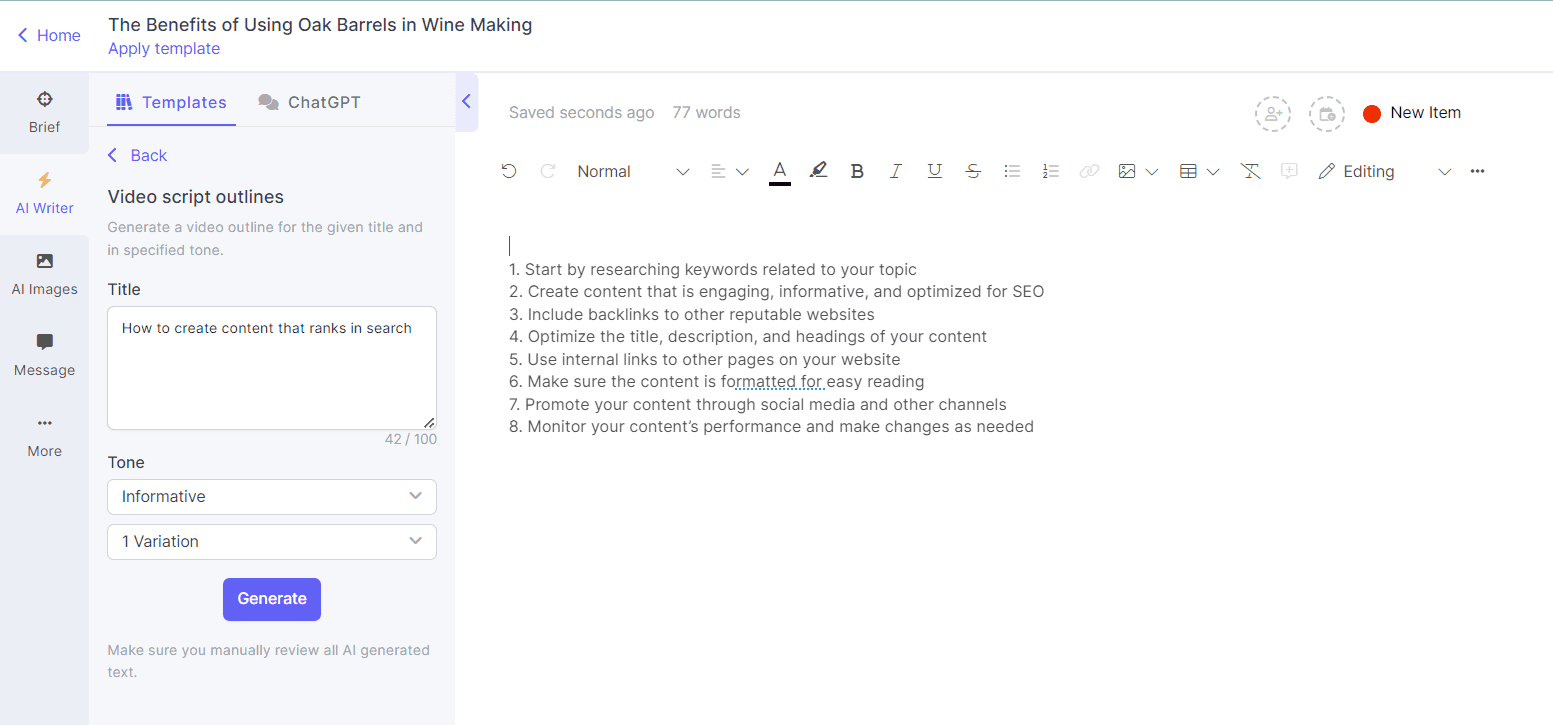
For more detailed scripts, complete with scenes and narration, you can use ChatGPT. It gives you a complete script from start to finish, leaving very little for you to clean up.
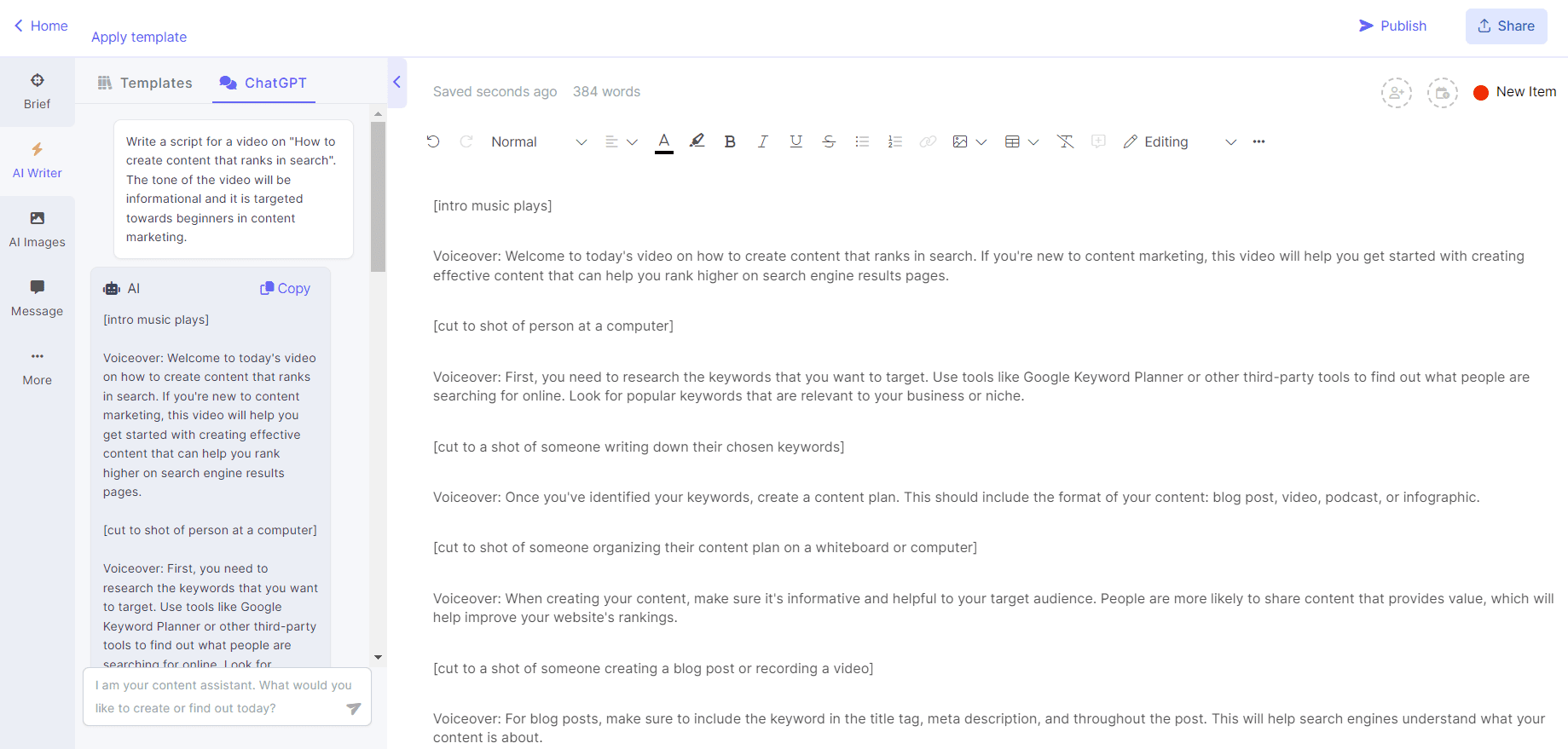
Translating content with generative AI for localization
The world is becoming a smaller place as businesses from one part of the globe are delivering products and services to all markets across oceans. But one challenge that this poses for marketers is the need to connect with the local audience in the target market. Language can be a major hindrance and marketers rely heavily on it, be it for long-form content creation, ads, or to create visual content. Thankfully, with generative AI at your service, you don’t have to spend a fortune on hiring translators for every content marketing campaign.
Generative AI tools can also help with language translation which is a big plus in situations where geo-targeting is essential. There are several tools and platforms that help with language translation to let you create more targeted, localized content. Apart from ChatGPT and Google or Bing Translate, tools like Yandex, DeepL, and Trados Studio are some popular and accurate AI translation tools that you can use.
There are also platforms that offer both human translation and translation by natural language processing tools to give you a more refined output. Platforms like Unbabel and Taia use machine translations that are verified by human translators to give you an added layer of scrutiny.
Not just AI translation software, but even a multilingual AI writer can help you create content in local languages for various target markets. Tools like Ailaysa and Fluently let you generate and optimize content in multiple languages.
Generate contextual and personalized images for ads and more with generative AI
Generative AI helps not just with text but with visual content too. Images play a central role in most content marketing campaigns but finding the right images that capture the essence of your message may be tough. No attribution required stock images may be helpful, but they are being used everywhere else by everyone. If you want to add images that are unique to your content, you either have to create them yourself or have AI image generator tools create them for you.
An AI image generator tool can generate custom images, art, and graphics from simple text prompts. All you have to do is describe the image you want, including the style, color palettes, and other details. The more comprehensive your description, the better the AI-generated images will be. Here’s an example from Narrato’s AI image generator.
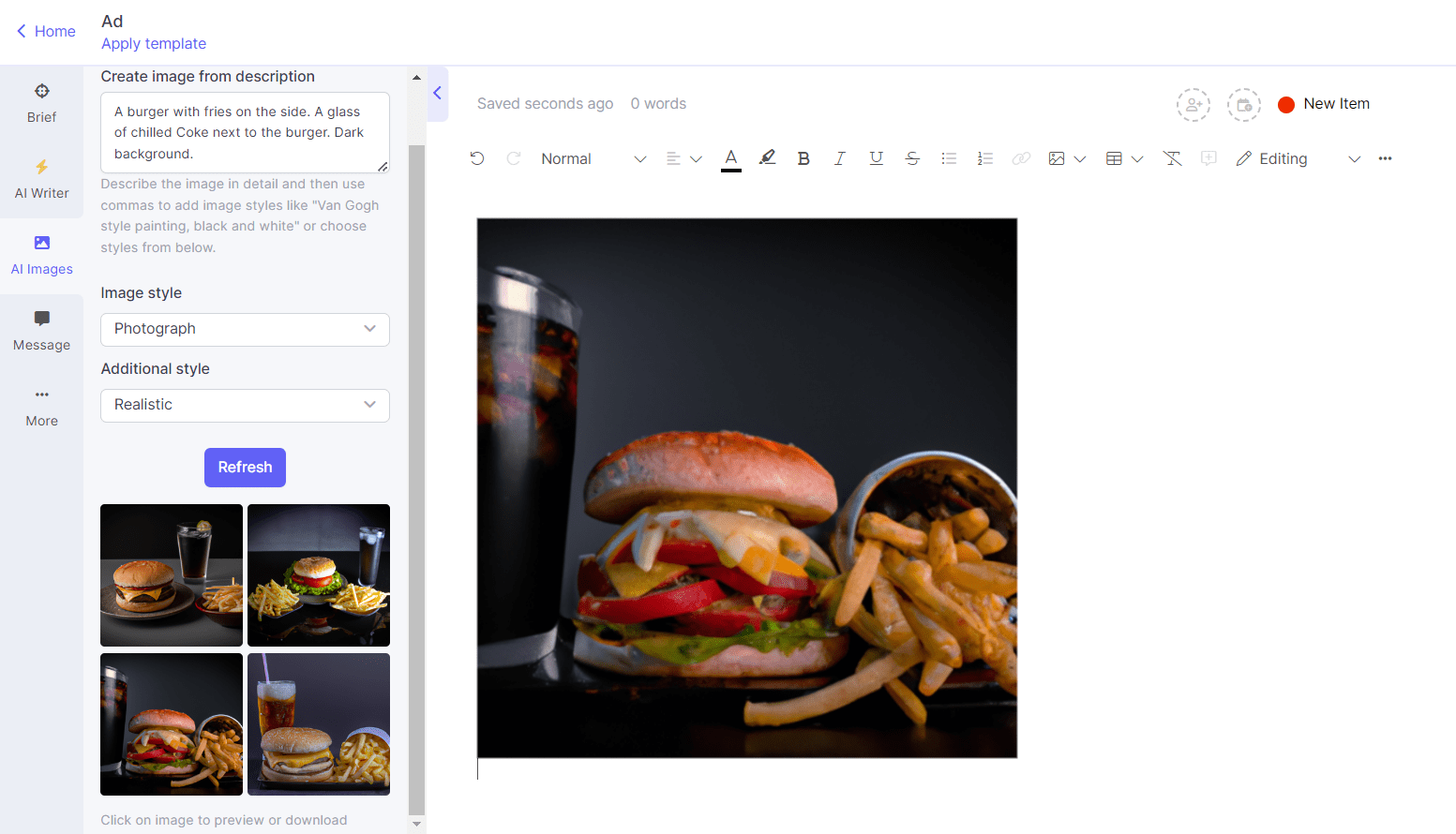
There are several other AI content creation tools for images and graphics as well. Canva, for instance, has an AI image generator and graphic designer as well. Other AI image generation tools include Craiyon, Gencraft, and Starry AI, to name a few.
Generate audio and video content with generative pre-trained AI tools
Video and audio content are two of the highest consumed content formats today. As of 2022, videos were the second most created content type after short articles, with 61% of marketers using video content. But video marketing can be expensive. From hiring presenters to renting studios for video production, it is a huge expenditure that most small and mid-sized businesses cannot afford. But since videos are more personal and are capable of connecting with the audience as compared to text or other formats, it is an invaluable marketing tool as well.
This is where generative AI is proving to be a game-changer. Generative AI tools that help create videos, voiceovers, short clips for social media, etc. are making this whole affair simpler and more affordable for everyone, irrespective of business size. There are AI tools that can generate videos with AI avatars and human voiceovers.
Some popular generative AI tools for video marketing and podcasting are Synthesys, DeepbrainAI, and HeyGen, among others.
Best practices when using Generative AI for creating hyper-targeted content
There is no doubt about it that generative AI is a blessing for content creators and marketers. From boosting content creation speeds to minimizing costs to enhancing the customer experience with personalized, high-quality content, the benefits of AI content creation tools are well-known. But there is a right way to use AI tools as well. Like most other technology, generative AI has its limitations too.
As these tools are pre-trained on historical data, there are chances that some inherent bias or inaccuracies may seep into the content they generate. That is why, it is essential to have some human oversight even when using AI writing tools, image generators, or other tools.
Some best practices to follow when using generative AI are –
- Understand what AI is and is not capable of. Especially when using an AI writer, remember that it cannot create original ideas or thought leadership content. It can only create content based on the data it has been trained on.
- Know the copyright rules for AI-generated content. In most cases, especially with art and images, AI-generated content may not be protected by copyright laws. The rules may vary from one circumstance to another and it is important to be educated on this front.
- Ensure that you are not violating any terms, either at the publisher’s end or at the AI platform’s end. Find out of the publishing platform accepts Ai-generated content (which in most cases they do, as long as the content is helpful and has human touch). Also, find out if the AI platform allows you to use the generated content for commercial purposes without any attribution required.
- Use generative AI as the first step, not the final step. AI content generators usually give you a very clean first draft, but it is always important to review and edit the content where possible to make it flow better and look/sound more human. Ideally, your audience shouldn’t be able to identify which content is AI-generated.
- Be specific and comprehensive with your prompts. The more focused your prompts are, the more likely it is that the AI output will be closer to what you are looking for. But again, avoid using prompts that can land you in conflict, such as names of individuals or celebrities, specific brands, design styles, etc.
Wrapping up
Generative AI has revolutionized the way businesses approach content creation. With the ability to create unique, hyper-targeted content in a matter of seconds, marketers can now engage their audiences in a more personalized and effective manner. By following best practices such as setting clear parameters, reviewing output regularly, and constantly refining the process, you can ensure that AI-generated content is not only high-quality but also aligned with your overall strategy. With the tremendous potential of generative AI, it makes for a powerful tool to differentiate yourself in this highly competitive landscape and deliver greater value to your audiences.


